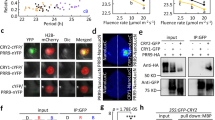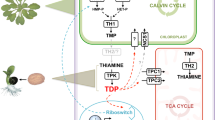Abstract
In the last decade, the view of circadian oscillators has expanded from transcriptional feedback to incorporate post-transcriptional, post-translational, metabolic processes and ionic signalling. In plants and animals, there are circadian oscillations in the concentration of cytosolic free Ca2+ ([Ca2+]cyt), though their purpose has not been fully characterized. We investigated whether circadian oscillations of [Ca2+]cyt regulate the circadian oscillator of Arabidopsis thaliana. We report that in Arabidopsis, [Ca2+]cyt circadian oscillations can regulate circadian clock function through the Ca2+-dependent action of CALMODULIN-LIKE24 (CML24). Genetic analyses demonstrate a linkage between CML24 and the circadian oscillator, through pathways involving the circadian oscillator gene TIMING OF CAB2 EXPRESSION1 (TOC1).
This is a preview of subscription content, access via your institution
Access options
Access Nature and 54 other Nature Portfolio journals
Get Nature+, our best-value online-access subscription
$29.99 / 30 days
cancel any time
Subscribe to this journal
Receive 12 digital issues and online access to articles
$119.00 per year
only $9.92 per issue
Buy this article
- Purchase on Springer Link
- Instant access to full article PDF
Prices may be subject to local taxes which are calculated during checkout






Similar content being viewed by others
References
Dodd, A. N. et al. Plant circadian clocks improve growth, competitive advantage and survival. Science 309, 620–623 (2005).
Harmer, S. L. The circadian system in higher plants. Annu. Rev. Plant Biol. 60, 357–377 (2009).
Gardner, M. J., Hubbard, K. E., Hotta, C. T., Dodd, A. N. & Webb, A. A. R. How plants tell the time. Biochem. J. 397, 15–24 (2006).
Wang, Z. Y. et al. A MYB-related transcription factor is involved in the phytochrome regulation of an Arabidopsis Lhcb gene. Plant Cell 9, 491–507 (1997).
Schaffer, R. et al. The late elongated hypocotyls mutation of Arabidopsis disrupts circadian rhythms and the photoperiodic control of flowering. Cell 93, 1219–1229 (1998).
Farré, E. M., Harmer, S. L., Harmon, F. G., Yanovsky, M. J. & Kay, S. A. Overlapping and distinct roles of PRR7 and PRR9 in the Arabidopsis circadian clock. Curr. Biol. 15, 47–54 (2005).
Millar, A. J., Carré, I. A., Strayer, C. A., Chua, N. H. & Kay, S. A. Circadian clock mutants in Arabidopsis identified by luciferase imaging. Science 267, 1161–1163 (1995).
Park, D. H. et al. Control of circadian rhythms and photoperiodic flowering by the Arabidopsis GIGANTEA gene. Science 285, 1579–1582 (1999).
Alabadí, D. et al. Reciprocal regulation between TOC1 and LHY/CCA1 within the Arabidopsis circadian clock. Science 293, 880–883 (2001).
Pruneda-Paz, J. L., Breton, G., Para, A. & Kay, S. A. A functional genomics approach reveals CHE as a component of the Arabidopsis circadian clock. Science 323, 1481–1485 (2009).
Haydon, M. J., Mielczarek, O., Robertson, F. C., Hubbard, K. E. & Webb, A. A. R. Photosynthetic entrainment of the Arabidopsis thaliana circadian clock. Nature 502, 689–692 (2013).
Malapeira, J., Khaitova, L. C. & Más, P. Ordered changes in histone modifications at the core of the Arabidopsis circadian clock. Proc. Natl Acad. Sci., USA 109, 21540–21545 (2012).
Asher, G. et al. Poly(ADP-ribose) polymerase 1 participates in the phase entrainment of circadian clocks to feeding. Cell 142, 943–953 (2010).
Nahakata, Y., Sahar, S., Astarita, G., Kaluzova, M. & Sassone-Corsi, P. Circadian control of the NAD+salvage pathway by CLOCK-SIRT1. Science 324, 654–657 (2009).
Más, P. Circadian clock function in Arabidopsis thaliana: time beyond transcription. Trends Cell Biol. 18, 273–281 (2008).
Dodd, A. N. et al. A cADPR-based feedback loop modulates the Arabidopsis circadian clock. Science 318, 1789–1792 (2007).
Somers, D. E., Schultz, T. F., Milnamow, M. & Kay, S. A. ZEITLUPE encodes a novel clock-associated PAS protein from Arabidopsis. Cell 101, 319–329 (2000).
Kim, W. Y. et al. ZEITLUPE is a circadian photoreceptor stabilized by GIGANTEA in blue light. Nature 449, 356–360 (2007).
Más, P., Kim, W. Y., Somers, D. E. & Kay, S. A. Targeted degradation of TOC1 by ZTL modulates circadian function in Arabidopsis thaliana. Nature 426, 567–570 (2003).
Feeney, K. A. et al. Daily magnesium fluxes regulate cellular timekeeping and energy balance. Nature 532, 375–379 (2016).
Tataroglu, O. et al. Calcium and SOL protease mediate temperature resetting of circadian clocks. Cell 163, 1214–1224 (2015).
Hong, S., Kim, S. A., Guerinot, M. L. & McClung, C. R. Reciprocal interaction of the circadian clock with the iron homeostasis network in Arabidopsis. Plant Physiol. 161, 893–903 (2013).
Harrisingh, M. C., Wu, Y., Lnenicka, G. A. & Nitabach, M. N. Intracellular Ca2+ regulates free-running circadian clock oscillation in vivo. J. Neurosci. 27, 12489–12499 (2007).
Johnson, C. H. et al. Circadian oscillations of cytosolic and chloroplastic free calcium in plants. Science 269, 1863–1865 (1995).
Hong, J. H. et al. Intracellular calcium spikes in rat suprachiasmatic nucleus neurons induced by BAPTA-based calcium dyes. PloS One 5, e9634 (2010).
Sánchez, J. P., Duque, P. & Chua, N. H. ABA activates ADPR cyclase and cADPR induces a subset of ABA-responsive genes in Arabidopsis. Plant J. 38, 381–395 (2004).
Ikeda, M. Calcium dynamics and circadian rhythms in suprachiasmatic nucleus neurons. The Neuroscientist 10, 315–324 (2004).
Leckie, C. P., McAinsh, M. R., Allen, G. J., Sanders, D. & Hetherington, A. M. Abscisic acid-induced stomatal closure mediated by cyclic ADP-ribose. Proc. Natl Acad. Sci. USA. 95, 15837–15842 (1998).
Xu, X. et al. Distinct light and clock modulation of cytosolic free Ca2+ oscillations and rhythmic CHLOROPHYLL A/B BINDING PROTEIN2 promoters activity in Arabidopsis. Plant Cell 19, 3474–3490 (2007).
Love, J., Dodd, A. N. & Webb, A. A. R. Circadian and diurnal calcium oscillations encode photoperiodic information in Arabidopsis. Plant Cell 16, 956–966 (2004).
Fogelmark, K. & Troein, C. Rethinking transcriptional activation in the Arabidopsis circadian clock. PLoS Comput. Biol. 10, e1003705 (2014).
Whalley, H. J. et al. Transcriptomic analysis reveals calcium regulation of specific promoter motifs in Arabidopsis. Plant Cell 23, 4079–4095 (2011).
Conklin, P. L., Pallanca, J. E., Last, R. L. & Smirnoff, N. L-ascorbic acid metabolism in the ascorbate deficient Arabidopsis mutant vtc1. Plant Physiol. 115, 1277–1285 (1997).
Delk, N. A., Johnson, K. A., Chowdhury, N. I. & Braam, J. CML24, regulated in expression by diverse stimuli, encodes a potential Ca2+ sensor that functions in responses to abscisic acid, daylength, and ion stress. Plant Physiol. 139, 240–253 (2005).
Tsai, Y. C., Delk, N. A., Chowdhury, N. I. & Braam, J. Arabidopsis potential calcium sensors regulate nitric oxide levels and the transition to flowering. Plant Signal. Behav. 2, 446–454 (2007).
Braam, J. Regulated expression of the calmodulin-related TCH genes in cultured Arabidopsis cells: induction by calcium and heat shock. Proc. Natl Acad. Sci. USA. 89, 3213–3216 (1992).
McCormack, E., Tsai, Y. C. & Braam, J. Handling calcium signaling: Arabidopsis CaMs and CMLs. Trends Plant Sci. 10, 383–389 (2005).
Gibbs, D. J. et al. Nitric oxide sensing in plants is mediated by proteolytic control of group VII ERF transcription factors. Mol. Cell 53, 369–379 (2014).
Salomé, P. & McClung, C. R. PSEUDO-RESPONSE REGULATOR 7 and 9 are partially redundant genes essential for the temperature responsiveness of the Arabidopsis circadian clock. Plant Cell 17, 791–803 (2005).
Rugnone, M. L. et al. LNK genes integrate light and clock signaling networks at the core of the Arabidopsis oscillator. Proc. Natl Acad. Sci. USA. 110, 12120–12125 (2013).
McCormack, E. & Braam, J. Calmodulins and related potential calcium sensors of Arabidopsis. New Phytol. 159, 585–598 (2003).
La Verde, V., Dominici, P. & Astegno, A. Towards understanding plant calcium signaling through calmodulin-like proteins: a biochemical and structural perspective. Int. J. Mol. Sci. 19, 1331 (2018).
Zimmermann, P. et al. ExpressionData – A public resource of high quality curated datasets representing gene expression across anatomy, development and experimental conditions. BioData Mining 7, 18 (2014).
Kosugi, S., Suzuka, I. & Ohashi, Y. Two of three promoter elements identified in a rice gene for proliferating cell nuclear antigen are essential for meristematic tissue-specific expression. Plant J. 7, 877–886 (1995).
Hazen, S. P. et al. LUX ARRHYTHMO encodes a Myb domain protein essential for circadian rhythms. Proc. Natl Acad. Sci. USA. 102, 10387–10392 (2005).
Ding, Z., Millar, A. J., Davis, A. M. & Davis, S. J. TIME FOR COFFEE encodes a nuclear regulator in the Arabidopsis thaliana circadian clock. Plant Cell. 19, 1522–1536 (2007).
Mart¡, M. C., Stancombe, M. A. & Webb, A. A. R. Cell- and stimulus type-specific intracellular free Ca2+ signals in Arabidopsis. Plant Physiol. 163, 625–634 (2013).
Ramakers, C., Ruijter, J. M., Lekanne-Deprez, R. H. & Moorman, A. F. M. Assumption-free analysis of quantitative real-time polymerase chain reaction (PCR) data. Neurosci. Lett. 339, 62–66 (2003).
Acknowledgements
Supported by BBSRC UK research grants BBSRC BB/D010381/1 (A.N.D.), BB/D017904/1 (F.R.) BB/M00113X/1 (H.J.H.) awarded to (A.A.R.W.), Research Studentship (K.H.) and BBSRC Industrial Case (T.H.). A Swiss Science Foundation Award (PBZHP3-123289) and the Isaac Newton Trust Cambridge (M.C.M.R. and S.A.), the National Science Foundation under Grant No. MCB 0817976 (Y-C.T. and J.B.), a Royal Society Grant RG081257 and Corpus Christi College, Cambridge Junior Research Fellowship (M.J.G.), a Cordenadoria de Apoio ao Ensino Superior Brazil studentship (C.T.H.), IEF Marie Curie (Project No. 272186) (M.C.M.R.), a Broodbank Fellowship (M.C.M.R.), a Malaysian Government Studentship (N.I.M-H.). The funders had no role in study design, data collection and analysis, decision to publish, or preparation of the manuscript. The authors are very grateful to the unnamed laboratories who provided (un)published material for the screen.
Author information
Authors and Affiliations
Contributions
M.C.M.R., K.E.H., M.J.G., S.A., C.T.H., N.I.M-N., F.C.R., T.J.H., H.J.J., and A.N.D. performed the experiments and analysed the data. The effects of Ca2+ on circadian gene expression experiments were designed by M.J.G. and M.C.M.R. and performed by them with K.E.H., S.A., C.T.H., F.C.R. and A.N.D. Reverse genetic screening was performed by K.E.H. Analysis of cml23/cml24 mutants was performed by M.C.M.R., K.E.H., N.I.M-N., T.J.H. and H.J.J. Y-C.T. provided lines before publication and advice. M.C.M.R., K.E.H. and A.A.R.W. wrote the manuscript. M.H., I.A.C., J.M.D., J.B. and A.A.R.W. managed the project, advised on interpretation and obtained the funding.
Corresponding author
Ethics declarations
Competing interests
The authors declare no competing interests.
Additional information
Publisher’s note: Springer Nature remains neutral with regard to jurisdictional claims in published maps and institutional affiliations.
Supplementary information
Supplementary Information
Supplementary Table 1, Supplementary Methods, Supplementary Statistical Parameters, Supplementary References and Supplementary Figures 1–6
Supplementary Table 2
Reverse genetic screen of Ca2+ -signalling related mutants.
Supplementary Table 3
Circadian period estimates of leaf movement for characterization of the genetic relationship between CML23/CML24 and the clock genes. Relative to Figure 5, 6 and Supplementary Figure 4.
Rights and permissions
About this article
Cite this article
Martí Ruiz, M.C., Hubbard, K.E., Gardner, M.J. et al. Circadian oscillations of cytosolic free calcium regulate the Arabidopsis circadian clock. Nature Plants 4, 690–698 (2018). https://doi.org/10.1038/s41477-018-0224-8
Received:
Accepted:
Published:
Issue Date:
DOI: https://doi.org/10.1038/s41477-018-0224-8
This article is cited by
-
Dynamic monitoring of oscillatory enzyme activity of individual live bacteria via nanoplasmonic optical antennas
Nature Photonics (2023)
-
Restoring circadian gene profiles in clock networks using synthetic feedback control
npj Systems Biology and Applications (2022)
-
ZmCCT regulates photoperiod-dependent flowering and response to stresses in maize
BMC Plant Biology (2021)
-
Physiological and molecular advances in magnesium nutrition of plants
Plant and Soil (2021)
-
Diel magnesium fluctuations in chloroplasts contribute to photosynthesis in rice
Nature Plants (2020)



